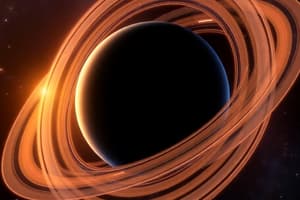Podcast
Questions and Answers
What are the rings of Saturn made of?
What are the rings of Saturn made of?
The rings of Saturn are clustered chunks of ice, rock, and dust, primarily ice.
How/when did the rings of Saturn get there?
How/when did the rings of Saturn get there?
- Two moons collided with each other.
- A comet crashed into a moon.
- The rings are being constantly replenished.
- All of the above. (correct)
Why are the rings of Saturn parallel?
Why are the rings of Saturn parallel?
The rings are parallel due to a centrifugal force that pulls material towards the equator, resulting in a greater gravitational force in that area.
Flashcards are hidden until you start studying
Study Notes
Rings Composition
- Composed mostly of ice, with smaller amounts of rock and dust.
- Sizes of ring particles vary from as small as grains of sand to as large as tall buildings.
- Particles orbit Saturn in concentric rings, each section traveling at different speeds.
Formation Theories
- Collision Theory: Suggests that the rings may have formed from a collision between two moons or from a comet impacting a moon, resulting in debris.
- Replenishment Theory: Indicates that rings are being continuously replenished. For example, Saturn's E-Ring is replenished by icy particles ejected from geysers on the moon Enceladus.
Parallel Structure of the Rings
- Parallel rings are a result of Saturn's slight oblateness due to centrifugal force.
- Greater mass congregates around the equator compared to the poles, leading to stronger gravitational pull at the equator.
- According to Newton's Law of Universal Gravitation, the gravitational force acting on the ring particles causes them to be drawn toward the equator, forming the parallel ring structure.
Studying That Suits You
Use AI to generate personalized quizzes and flashcards to suit your learning preferences.




